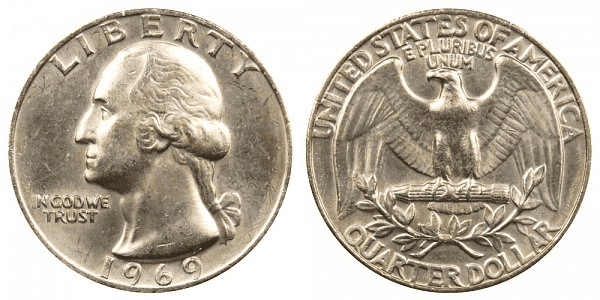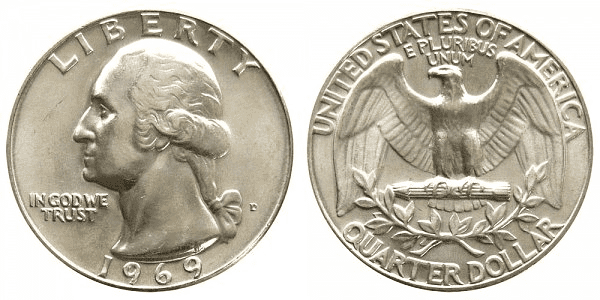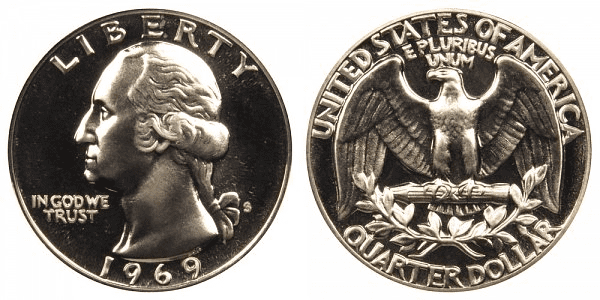What Is A 1969 Quarter Made Of?
Beginning in 1968, Washington Quarters had a 91.67% copper center with an 8.33% nickel coating instead of the earlier coins’ silver composition. The bust of Jean-Antoine Houdon from 1786 served as the inspiration for John Flanagan’s depiction of George Washington facing left on the coin’s obverse.
Above Washington’s hair and around the top of the coin, the word LIBERTY is printed. The bottom of the truncated George Washington bust has the year “1968” inscribed around it. The country’s motto, IN GOD WE TRUST, is located to the left of Washington.
The reverse of the coin shows an eagle with an Art Deco heraldic design resting on a sheaf of arrows. Both the eagle’s head and the arrows point to the left. Around the base of the eagle are two sprays of olive branches arranged in the form of a U. United States of America is written all the way around the top of the coin.
The motto E PLURIBUS UNUM appears below it. The word “QUARTER DOLLAR” is written on the coin’s base. The 1969 Washington quarter has a reeded edge.
During the American Apollo 11 mission in 1969, Neil Armstrong and Edwin “Buzz” Aldrin made history by being the first humans to set foot on the moon. Woodstock attracts more than 350,000 rock and roll fans, and The Beatles recorded Abbey Road, their final album together.
1969 Quarter Varieties
1969 Quarter With No Mint Mark
Year: 1969
Face Value: $0.25
Composition: 91.67% Copper and 8.33% Nickel
Total Weight: 5.67g
Diameter: 24.3 mm
Thickness: 1.95 mm
Edge: Reeded
Minted in: Philadelphia
Quantity Minted: 176,212,000

photo source: www.usacoinbook.com
1969 D Quarter
Year: 1969
Face Value: $0.25
Composition: 91.67% Copper and 8.33% Nickel
Total Weight: 5.67g
Diameter: 24.3 mm
Thickness: 1.95 mm
Edge: Reeded
Minted in: Denver
Quantity Minted: 114,372,000

photo source: www.usacoinbook.com
1969 S Proof Quarter
Year: 1969
Face Value: $0.25
Composition: 91.67% Copper and 8.33% Nickel
Total Weight: 5.67g
Diameter: 24.3 mm
Thickness: 1.95 mm
Edge: Reeded
Minted in: San Francisco
Quantity Minted: 2,934,631

photo source: www.usacoinbook.com
List of errors
Doubled Die Error
A rare 1969 doubled die quarter could be worth $125 or more, although the majority of coins that novice collectors mistake for doubled dies actually only exhibit the indications of standard machine doubling. Look for doubling in the writing on both sides of the coin, the eagle’s feathers, Washington’s eye, and his hairline.
Broadstrike
A 1969 U.S. quarter without ridges or edge reeding has reportedly been found by many people.
Others believe there is a problem with the brown copper edge of the coin or that there is no copper color at all. Post-mint deterioration is the main cause of these 1969 quarter no ridge and/or rim errors.
A broadstrike, a type of rim mistake on 1969 quarters, has no edge reeding at all and has an appearance that is flatter and wider than a typical quarter. These will definitely be kept! An error from the 1969 quarter may sell for $25 or more.
Off-center Strike
The off-center strike, which often seems very severe and unusual, is one of the most common quarter faults. It is possible for a 1969 U.S. quarter to be struck off center by as little as 1% to 5% or as much as 90%. For a tiny inaccuracy like this, a 1969 quarter that is 10% or 20% off center may bring in a bid of $20 or $30. However, it can cost $150 or even more if you find a 1969 quarter that is roughly 50% off center but still displays the entire date.
How Much Is A 1969 Quarter Worth Today?
The low $0.052 melt value of a 1968 quarter indicates that any value (beyond the face value) associated with this money comes from considerations such as condition, flaws, and provenance. This coin has no melt value because it doesn’t contain any precious metal.
With the exception of MS grade coins, which are only worth their face value since they are still in circulation, these coins’ principal value, excluding rarities, is determined by their condition.
| Type of 1969 Quarter | Condition | Estimated Value |
| 1969 Quarter with No Mintmark | Circulated | Face Value |
| Uncirculated | $5-$50+ | |
| 1969 D Quarter | Circulated | Face Value |
| Uncirculated | $4-$18+ | |
| 1969 Proof Quarters | Average | $2-$3 |
| Mint | $100+ |
How Does The Grading System Work?
The Sheldon Scale is used by numismatists to provide a numerical value to coins. The Sheldon Scale goes from poor (P-1) to perfect mint state (P-1) (MS-70). Coins were originally evaluated using words to reflect their condition (Good, Fair, Excellent, Etc.). Unfortunately, coin collectors and dealers had different ideas about what each of these terms represent.
Professional numismatists joined together in the 1970s and established CoinGrading standards. These numismatists now assign grades at key places on the seventy-point scale, using the most regularly utilized numeric points in conjunction with the original adjective grade. The following are the most common coin grades:
-
-
- (P-1) Poor – Indistinguishable and probably damaged; if used, must have a date and mintmark; otherwise, rather battered.
- (FR-2) Fair – Nearly smooth, but without the damage that a coin graded Poor often possesses. The coin must have enough detail to be identified.
- (G-4) Fair – Inscriptions have merged into the rims in some areas, and important elements have been mostly erased.
- (VG-8) Very Good- A little weathered, but all of the primary design elements are visible, albeit faintly. There is little if any, central detail left.
- (F-12) Good – The item is very worn, yet the wear is even, and the overall design details stand out clearly. Rims are almost completely isolated from the field.
- (VF-20) Very Fine – Moderately weathered, with some finer features still visible. The motto or all letters of LIBERTY are readable. Both sides of the coin have entire rims that are separated from the field.
- (EF-40) Extremely Fine – Gently used; all gadgets are visible, and the most important ones are bold. The finer details are bold and clear, however, light wear may be seen.
- (AU-50) Uncirculated – Slight evidence of wear on the coin’s design’s high points; may have contact marks; eye appeal should be adequate.
- (AU-58) Uncirculated Choice – Slight traces of wear, no severe contact marks, almost full mint shine, and great eye appeal.
- (MS-60) Mint State Basal – Strictly uncirculated; no indication of wear on the coin’s highest points, but an unsightly coin with reduced luster, visible contact marks, hairlines, and other flaws.
- (MS-63) Mint State Acceptable – Uncirculated, but with contact scratches and nicks, little reduced shine, but otherwise appealing appearance. The strike is weak to average.
- (MS-65) Mint State Choice – Uncirculated with great mint shine, very little contact blemishes, and exceptional eye appeal. The strike is unusually severe.
- (MS-68) Mint State Premium Quality – Uncirculated with superb luster, no obvious contact marks to the naked eye, and exceptional eye appeal. The strike is quick and appealing.
- (MS-69) Almost Perfect Mint State – Uncirculated with perfect brilliance, a sharp and appealing strike, and extremely good eye appeal. A near-perfect coin with minor imperfections in the planchet, strike, and contact markings (seen only under 8x magnification).
- (MS-70) Mint State Perfect – Under 8x magnification, there are no tiny imperfections discernible; the strike is crisp, and the coin is perfectly centered on a beautiful planchet. Rarely seen on a coin, this coin is bright and whole, with original luster and exceptional eye appeal.
-
Where To Buy Or Sell 1969 Quarters?
There are several 1969 quarters to watch out for, so if you have one in your collection, it might be worth studying it over closely to look for any flaws or unique qualities before you think about selling. On websites like Etsy and eBay, regular 1969 quarters can be purchased or sold for a few dollars.
If you’re unsure but believe you might have something unusual, you can post an image in a forum for coin collectors to get advice from other collectors.
You may prevent fraud while purchasing and selling rare 1968 quarters by only dealing with reputable, specialized dealers like Heritage Auctions.
Are There Any Rare 1969 Quarters?
Even in mint state, the 1969 quarter is not scarce because of its mintage of approximately 176 million business strikes. However, due to the poor strike quality seen in this year and the fact that original B.U. rolls of this issue are almost unheard of finding a highly graded non-proof Washington Quarter is a rare thing, and PCGS has only graded three coins at MS-67 since 1986, and fewer than 75 in MS-66.
A few times per year, the 1969 quarter in MS-66 is put up for auction. It’s a rare coin to locate in any condition; it’s not just rare to find in high grades. The last time an MS-67 was purchased was in February 2001 for $825. The coin is in a very early die stage and has very little distracting frost on the devices. Without a doubt, if presented today, this item would easily sell for three or four times that amount.
FAQs
What is the value of a 1969 Canadian quarter?
1969 Canadian quarters don’t have any silver content which means that like the Washington quarter, they have a low melt value, and better condition examples are worth a maximum of $0.75
Is the 1969 Canadian quarter silver?
From 1920 to 1967, the quarter contained 0.15 troy ounces of silver, which is 0.60 oz for the silver dollar, 0.50 oz for the 50-cent coin, and 2 and a half times that much for the dime. However, from 1968 onwards, the silver content was removed.
Where is the mint mark on a 1969 quarter located?
The mint mark on a 1969 quarter is found on the obverse side of the coin to the right of Washington’s pony tail.



